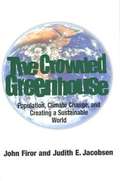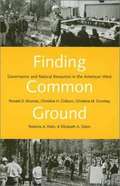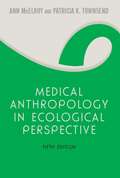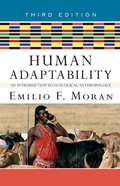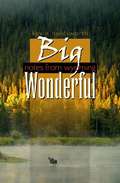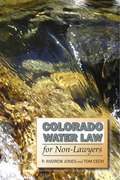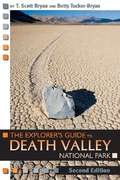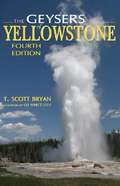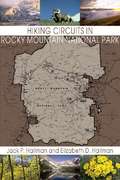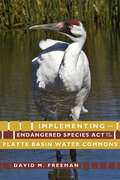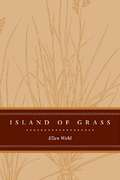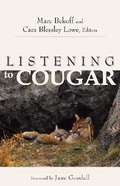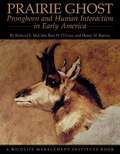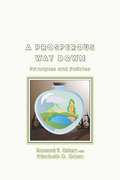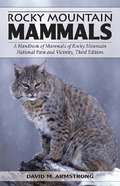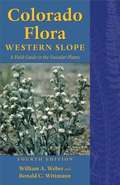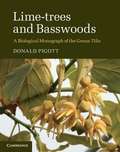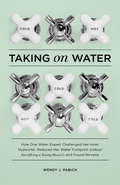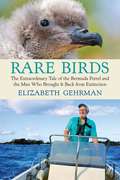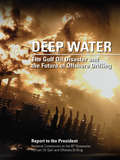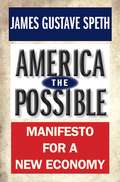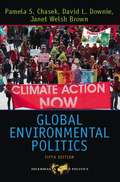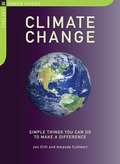- Table View
- List View
The Crowded Greenhouse: Population, Climate Change, and Creating a Sustainable World
by John Firor Judith JacobsenWhat is the best way to move our planet to a safe and sustainable future? This book focuses on two global issues - rapid population growth and a human-induced climate change caused by emissions - that lie at the heart of this problem. John Firor and Judith Jacobsen summarize the current status of these two issues, show how they are related to one another, and prescribe steps that governments, economies, societies, and individuals can adopt to ensure their stability." --BOOK JACKET. Title Summary field provided by Blackwell North America, Inc. All Rights Reserved
Finding Common Ground: Governance and Natural Resources in the American West
by Ronald D. Brunner Christine H. Colburn Christina M. Cromley Roberta A. KleinOver the past century, solutions to natural resources policy issues have become increasingly complex. Multiple government agencies with overlapping jurisdictions and differing mandates as well as multiple interest groups have contributed to gridlock, frequently preventing solutions in the common interest. Community-based responses to natural resource problems in the American West have demonstrated the potential of local initiatives both for finding common ground on divisive issues and for advancing the common interest. The first chapter of this enlightening book diagnoses contemporary problems of governance in natural resources policy and in the United States generally, then introduces community-based initiatives as responses to those problems. The next chapters examine the range of successes and failures of initiatives in water management in the Upper Clark Fork River in Montana; wolf recovery in the northern Rockies; bison management in greater Yellowstone; and forest policy in northern California. The concluding chapter considers how to harvest experience from these and other cases, offering practical suggestions for diverse participants in community-based initiatives and their supporters, agencies and interest groups, and researchers and educators.
Medical Anthropology in Ecological Perspective
by McelroyMcElroy and Townsend (both of the State U. of New York at Buffalo) present the fifth edition of their text introducing the field of medical anthropology. Their aim is to bring together the varied strands of medical anthropology--ethnographic studies of illness beliefs, curing rituals, and herbal medicines; study of the role of disease and climate as factors in human evolution; work on cross-cultural communication in public health; and study of human relationships to their environments in contemporary settings and in the past--using an ecological model and the concept of medical ecology. They present chapters on the ecology of health and disease; interdisciplinary research in health problems; genes, culture, and adaptation; changing patterns of disease and health; the ecology and economics of nutrition; culture, ecology, and reproduction; stress, illness, and healing; health resources in changing cultures; costs and benefits of development; and medical anthropology practices in the 21st century. Interspersed throughout are 16 "profiles" (five new to this edition): case studies that illustrate points made in the rest of the text through examples of current research in medical anthropology, with examples including demographic analysis of census data in post-Soviet Siberian villages, focus group research with inner-city teens in urban Connecticut, and a team project designed to reduce the rates of cholera in rural Ecuador. Annotation ©2009 Book News, Inc. , Portland, OR (booknews. com)
Human Adaptability
by Emilio F. MoranMoran (anthropology, Indiana U. ) provides a wealth of examples as he explains how people work in ecosystems. He begins by explaining theories of human-habitat interaction and introduces cultural ecological methods and notions about the human factor in environmental change and spatial analysis. He examines evidence of human adaptation from the arctic to high altitudes, arid lands, grasslands and the humid tropics, then thoroughly explores life in an urban ecology. The maps, photos and graphics are well-chosen and informative, and Moran has provided new chapters in urban sustainability and methods of spatial analysis, new sections giving websites, and increased attention to global environmental changes and the role of gender in human adaptability research for this edition. Annotation ©2008 Book News, Inc. , Portland, OR (booknews. com)
Big Wonderful
by Kevin HoldsworthIn this unconventional memoir, Kevin Holdsworth vividly portrays life in remote, unpredictable country and ruminates on the guts - or foolishness - it takes to put down roots and raise a family in a merciless environment. Growing up in Utah, Holdsworth couldn't wait to move away. Once ensconced on the East Coast, however, he found himself writing westerns and dreaming of the mountains he'd skied and climbed. Fed up with city life, he moved to a small Wyoming town. In Big Wonderful, he writes of a mountaineering companion's death, the difficult birth of his son, and his father's terminal illness - encounters with mortality that sharpened his ideas about risk, care, and commitment. He puts a new spin on mountaineering literature, telling wild tales from his reunion with the mountains but also relating the surprising willpower it took to turn back from risks he would have taken before he became a father. He found he needed courage to protect and engage deeply with his family, his community, and the wild places he loves. Holdsworth's essays and poems are rich with anecdotes, characters, and vivid images. Readers will feel as if they themselves watched a bear destroy an entire expedition's food, walked with his great-great-grandmother along the icy Mormon Trail, and tried to plant a garden in Wyoming's infamous wind. Readers who love the outdoors will enjoy this funny and touching take on settling down and adventuring in the West's most isolated country.
Colorado Water Law for Non-Lawyers
by Tom Cech P. Andrew JonesWhy do people fight about water rights? Who decides how much water can be used by a city or irrigator? Does the federal government get involved in state water issues? Why is water in Colorado so controversial? These questions, and others like them, are addressed in Colorado Water Law for Non-Lawyers. This concise and understandable treatment of the complex web of Colorado water laws is the first book of its kind. Legal issues related to water rights in Colorado first surfaced during the gold mining era of the 1800s and continue to be contentious today with the explosive population growth of the twenty-first century. Drawing on geography and history, the authors explore the flashpoints and water wars that have shaped Colorado's present system of water allocation and management. They also address how this system, developed in the mid-1800s, is standing up to current tests - including the drought of the past decade and the competing interests for scarce water resources - and predict how it will stand up to new demands in the future. This book will appeal to non-lawyers involved in water quality issues, students, and attorneys and water professionals desiring a succinct and readable summary of Colorado water law, as well as general readers interested in Colorado's complex water rights law.
The Explorer's Guide to Death Valley, Second Edition
by Betty Tucker-Bryan T. Scott BryanOriginally published in 1995, soon after Death Valley National Park became the fifty-third park in the U.S. park system, The Explorer's Guide to Death Valley National Park was the first complete guidebook available for this spectacular area. Now in its second edition, this is still the only book that includes all aspects of the park. Much more than just a guidebook, it covers the park's cultural history, botany and zoology, hiking and biking opportunities, and more. Information is provided for all of Death Valley's visitors, from first-time travelers just learning about the area to those who are returning for in-depth explorations. Rewritten, reorganized, and revised, the book includes updated point-to-point logs for every road within and around the park, as well as new maps more accurate than those in any other publication. With extensive input from National Park Service resource management, law enforcement, and interpretive personnel, as well as a thorough bibliography for suggested reading, The Explorer's Guide to Death Valley National Park, Second Edition is the most up-to-date, accurate, and comprehensive guide available for this national treasure.
The Geysers of Yellowstone, Fourth Edition
by T. Scott BryanThis revised popular field guide describes in detail each of the more than 500 geysers in Yellowstone National Park. With updated information and a new foreword by park archivist Lee Whittlesey, Geysers of Yellowstone is both a reference work and a fine introduction to the nature of geyser activity for the newcomer to geothermal phenomena. A glossary of key terms is provided, along with a comprehensive appendix that discusses other geyser areas of the world. Detailed maps accompany each geyser basin described, and tables are provided for easy reference.
Hiking Circuits in Rocky Mountain National Park
by Jack P. Hailman Elizabeth D. HailmanHiking Circuits in Rocky Mountain National Park is the first guide dedicated entirely to the loop trails of Rocky Mountain National Park, trails that return hikers to their starting point without the necessity of retracing steps or walking on roads. Having explored the park extensively for over 30 years, Jack and Elizabeth Hailman describe and map 33 circuits and component loops, with detailed driving instructions to the access points. Circuits range from a 15-minute stroll around a lake to strenuous all-day outings in the high country and even a few multi-day backpacking trips. Side trips are often recommended for viewing a scenic waterfall, summit, lake, or other natural feature. A convenient table lists circuits by walking time, allowing hikers to choose loops designed to fit their schedules. Each account includes a map, directions to the trailhead, trail distance, estimated hiking time, elevation range, exertion rating, segment descriptions for both clockwise and counter-clockwise hikes, and trail notes about the wildflowers, animals, and other natural history features encountered by the authors. Included are appendices for natural history, local hiking supply stores, and fee schedules, with an extensive bibliography for reading and reference.
Implementing the Endangered Species Act on the Platte Basin Water Commons
by David M. FreemanWater users of the Platte River Basin have long struggled to share this scarce commodity in the arid high plains, ultimately organizing collectively owned and managed water systems, allocating water along extensive stream systems, and integrating newer groundwater with existing surface-water uses. In 1973, the Endangered Species Act brought a new challenge: incorporating the habitat needs of four species-the whooping crane, piping plover, least tern, and pallid sturgeon-into its water-management agenda. Implementing the Endangered Species Act on the Platte Basin Water Commons tells of the negotiations among the U.S. Department of the Interior, the environmental community, and the states of Wyoming, Colorado, and Nebraska that took place from the mid-1970s to 2006. Ambitious talks among rival water users, environmentalists, state authorities, and the Department of the Interior finally resulted in the Platte River Habitat Recovery Program. Documenting how organizational interests found remedies within the conditions set by the Endangered Species Act, describing how these interests addressed habitat restoration, and advancing sociological propositions under which water providers transcended self-interest and produced an agreement benefiting the environment, this book details the messy process that took place over more than thirty years. Presenting important implications for the future of water management in arid and semi-arid environments, this book will be of interest to anyone involved in water management, as well as academics interested in the social organization of common property.
Island of Grass
by Ellen E. WohlIsland of Grass tells the story of the Cathy Fromme Prairie Natural Area, a 240-acre preserve surrounded by housing developments in Fort Collins, Colorado. This small grassland is a remnant of the once-vast prairies of the West that early European explorers and settlers described as seas of grass. Agricultural land use and urban expansion during the past two centuries have fragmented and altered these prairies. All that remains today are small islands. These remnants cannot support some of the larger animals that once roamed the prairie, but they continue to support a diverse array of plants and animals and can still teach us much about grassland ecology. Through her examinations of daily changes during walks across the Fromme Prairie over the course of a year, Ellen Wohl explores one of the more neglected ecosystems in North America, describing the geology, soils, climate, ecology, and natural history of the area, as well as providing glimpses into the lives of the plants, animals, and microbes inhabiting this landscape. Although small in size, pieces of preserved shortgrass prairie like the Cathy Fromme Prairie Natural Area are rich, diverse, and accessible natural environments deserving of awareness, appreciation, and protection. Anyone concerned with the ecology and conservation of grasslands in general, the ecology and conservation of open space in urban areas, or the natural history of Colorado will be interested in this book.
Listening to Cougar
by Marc Bekoff Cara Blessley LoweThis spellbinding tribute to Puma concolor honors the big cat's presence on the land and in our psyches. In some essays, the puma appears front and center: a lion leaps over Rick Bass's feet, hurtles off a cliff in front of J. Frank Dobie, gazes at Julia Corbett when she opens her eyes after an outdoor meditation, emerges from the fog close enough for poet Gary Gildner to touch. Marc Bekoff opens his car door for a dog that turns out to be a lion. Other works evoke lions indirectly. Biologists describe aspects of cougar ecology, such as its rugged habitat and how males struggle to claim territory. Conservationists relate the political history of America's greatest cat. Short stories and essays consider lions' significance to people, reflecting on accidental encounters, dreams, Navajo beliefs, guided hunts, and how vital mountain lions are to people as symbols of power and wildness. Contributors include: Rick Bass, Marc Bekoff, Janay Brun, Julia B. Corbett, Deanna Dawn, J. Frank Dobie, Suzanne Duarte, Steve Edwards, Joan Fox, Gary Gildner, Wendy Keefover-Ring, Ted Kerasote, Christina Kohlruss, Barry Lopez, BK Loren, Cara Blessley Lowe, Steve Pavlik, David Stoner, and Linda Sweanor.
Prairie Ghost
by Bart W O'Gara Richard E Mccabe Henry M ReevesIn this lavishly illustrated volume, Richard E. McCabe, Bart W. O'Gara and Henry M. Reeves explore the fascinating relationship of pronghorn with people in early America, from prehistoric evidence through the Battle of Little Bighorn in 1876. The only one of fourteen pronghorn-like genera to survive the great extinction brought on by human migration into North America, the pronghorn has a long and unique history of interaction with humans on the continent, a history that until now has largely remained unwritten. With nearly 150 black-and-white photographs, 16 pages of color illustrations, plus original artwork by Daniel P. Metz, Prairie Ghost: Pronghorn and Human Interaction in Early America tells the intriguing story of humans and these elusive big game mammals in an informative and entertaining fashion that will appeal to historians, biologists, sportsmen and the general reader alike.
A Prosperous Way Down
by Elisabeth C. Odum Howard T. OdumA Prosperous Way Down, the last book by Howard T. and Elisabeth C. Odum, has shaped politics and planning as nations, states, and localities begin the search for ways to adapt to a future with vastly increased competition for energy. It considers ways in which a future with less fossil fuel could be peaceful and prosperous. Although history records the collapse of countless civilizations, some societies and ecosystems have managed to descend in orderly stages, reducing demands and selecting and saving what is most important. The authors make recommendations for a more equitable and cooperative world society, with specific suggestions based on their evaluations of trends in global population, wealth distribution, energy sources, conservation, urban development, capitalism and international trade, information technology, and education. Available for the first time in paperback, this thoughtful, provocative book forces us to confront assumptions about our world 's future and provides both a steadying hand and a call to action with its pragmatic analysis of a global transition.
Rocky Mountain Mammals, Third Edition
by David M. ArmstrongRevised, updated, and with more than 80 new color photographs, Rocky Mountain Mammals, Third Edition is a nontechnical guide to the mammals of the Southern Rocky Mountains and their foothills, with special emphasis on Rocky Mountain National Park and vicinity. Designed for quick reference and enjoyable reading, Rocky Mountain Mammals offers what most field guides don't - a wealth of fascinating information about each species. In seventy-two species accounts, David M. Armstrong describes each animal and its signs, habits, habitat, and natural history, noting times when seasonal events such as elk sparring occur. Introductory materials and appendices offer rich context and wildlife-watching support, including a checklist with page numbers for quick field reference, an identification key, a glossary, derivations of scientific names, and advice on how, when, and where to watch mammals. Armstrong introduces mammalian evolution, anatomy, and distribution and offers perspective on how the local fauna fits into its geographical setting and into past and potential future faunas of the region. This lavishly illustrated new edition will delight those who live in and visit the high country and foothills of the Southern Rockies and want to identify mammals and learn about their lives.
Colorado Flora: Western Slope
by William A. Weber Ronald C. Wittmann[C]learly a book that every Rocky Mountain botanist should own." -Arctic and Alpine Research Colorado Flora: Eastern Slope describes the remarkable flora of the state, distinctive in its altitudinal range, numerous microhabitats, and ancient and rare plants. Together with Colorado Flora: Western Slope, Fourth Edition, these volumes are designed to educate local amateurs and professionals in the recognition of vascular plant species so that they can be better stewards of our priceless and irreplaceable biological heritage. These thoroughly revised and updated editions reflect current taxonomic knowledge. The authors describe botanical features of this unparalleled biohistorical region and its mountain ranges, basins, and plains and discuss plant geography, giving detailed notes on habitat, ecology, and range. The keys contain interesting anecdotes and introductions for each plant family. Each volume includes a background of botanical work in the state, a complete glossary, indices to common and scientific names, references and suggested readings, and hundreds of illustrations. The books also contain a new contribution from Donald R. Farrar and Steve J. Popovich on moonworts. The fourth editions of Colorado Flora: Eastern Slope and Colorado Flora: Western Slope are ideal for both student and scientist and essential for readers interested in Colorado's plant life.
Closeup Shooting
by Cyrill HarnischmacherClose-up photography is one of the most fascinating areas in photography. This illustrated guide will take the reader on a journey into the wonderful world of small, smaller, and smallest objects and show him how he can capture their beauty with photographic images. Each step of the way will be carefully explained; how to choose the right equipment, how to use ambient light or create artificial lighting, and how to conceptualize and frame the perfect shot. Whereas the nature photographer is exploring facets and structures in his environment, the "table top photographer" is trying to shoot a small object, a product, or a small treasure for display on the web (e.g., eBay) or in print. Here, the choice of the appropriate lighting and backdrop, and the creative use of the camera's features are key to a perfect image. Cyrill Harnischmacher explains all aspects of close-up shooting for both inside the studio, as well as outdoors. This book is filled with beautifully illustrated examples and detailed instructions on how to set up a system and workflow for successful close-up photography.
Lime-Trees and Basswoods
by Donald PigottLime trees (Tilia spp. ) are widely distributed and locally important members of northern temperate broad-leaved forests. In marked contrast to the largely uniform morphology of the genus its taxonomic treatment has become increasingly confused and controversial, with over one hundred species and numerous subspecies described. Using extensive data from field studies of natural populations around the world, this book clarifies the situation, proposing a revised taxonomy of 23 species and 14 subspecies. Detailed descriptions are provided for all recognised taxa and are accompanied by illustrations. Data from herbaria and cultivated trees are used to extend the analyses where appropriate and type specimens are included to stabilise nomenclature. Lime tree ecology is also considered, with an exploration of experimental and analytical data on regeneration, growth and reproduction in relation to climate and soils. Additional material includes a glossary of botanical terms and appendices of herbarium codes and relevant physical concepts.
Snow Leopard
by Don HunterLike no other large cat, the snow leopard evokes a sense of myth and mysticism, strength and spirit shrouded in a snowy veil, seldom seen but always present. Giving a voice to the snow leopard, this collection of powerful first person accounts from an impressive cadre of scientist-adventurers grants readers a rare glimpse of this elusive cat and the remarkable lives of those personally connected to its future. These Stories from the Roof of the World resonate with adventure, danger, discovery, and most importantly hope for this magnificent big cat.Very little has been written about this mystical creature. Its remote and rugged habitat among the mightiest collection of mountains on Earth, proclaimed "The Roof of the World" by awe-struck explorers, make it one of the most difficult and expensive animals to study. After a millennia thriving in peaceful isolation, human encroachment, poaching and climate change threaten the snow leopards survival. Speaking on behalf of the snow leopard, these heart-felt stories will inform and inspire readers, creating the vital connection needed to move people toward action in saving this magnificent cat. Contributors include: Ali Abutalip Dahashof, Som B. Ale, Avaantseren Bayarjargal, Yash Veer Bhatnagar, Joseph L. Fox, Helen Freeman, Darla Hillard, Don Hunter, Shafqat Hussain, Rodney Jackson, Jan E. Janecka, Mitchell Kelly, Ashiq Ahmad Khan, Nasier A. Kitchloo, Evgeniy P. Kashkarov, Peter Matthiessen, Kyle McCarthy, Tom McCarthy, George B. Schaller, and Rinchen Wangchuk.
Taking on Water
by Wendy J. PabichWhen Wendy Pabich received a monthly water bill for 30,000 gallons (for a household of two people and one dog), she was chagrined. After all, she is an expert on sustainable water use. So she set out to make a change. Taking on Water is the story of the author's personal quest to extract and implement, from a dizzying soup of data and analysis, day-to-day solutions to reduce water use in her life. She sets out to examine the water footprint of the products she consumes, process her own wastewater onsite, revamp the water and energy systems in her home, and make appropriate choices in order to swim the swim. Part memoir, part investigation, part solution manual, the book is filled with ruminations on philosophy, science, facts, figures, and personal behavioral insights; metrics, both serious and humorous, to track progress; and guidelines for the general public for making small (or perhaps monumental) but important changes in their own lives. Told with humor and grace, Taking on Water offers a raw account of how deep we need to dig to change our wasteful ways.
Rare Birds: The Extraordinary Tale of the Bermuda Petrel and the Man Who Brought It Back from Extinction
by Elizabeth GehrmanThe inspiring story of David Wingate, a living legend among birders, who brought the Bermuda petrel back from presumed extinction David Wingate is known in Bermuda as the birdman and in the international conservation community as a living legend for single-handedly bringing back the cahow, or Bermuda petrel—a seabird that flies up to 82,000 miles a year, drinking seawater and sleeping on the wing. For millennia, the birds came ashore every November to breed on this tiny North Atlantic island. But less than a decade after Bermuda’s 1612 settlement, the cahows had vanished. Or so it was thought until the early 1900s, when tantalizing hints of their continued existence began to emerge. In 1951, two scientists invited fifteen-year-old Wingate along on a bare-bones expedition to find the bird. The team stunned the world by locating seven nesting pairs, and Wingate knew his life had changed forever. He would spend the next fifty years battling natural and man-made disasters, bureaucracy, and personal tragedy with single-minded devotion and antiestablishment outspokenness. In April 2009, Wingate saw his dream fulfilled, as the birds returned to Nonsuch, an island habitat that he had hand-restored, plant-by-plant, giving the Bermuda petrels the chance they needed in their centuries-long fight for survival.
Deep Water
by National Commission on the BP Deepwater Horizon Oil Spill Offshore DrillingOn April 20, 2010, the Macondo well blew out, costing the lives of 11 men, and beginning a catastrophe that sank theDeepwater Horizondrilling rig and spilled nearly 5 million barrels of crude oil into the Gulf of Mexico. The spill disrupted an entire region’s economy, damaged fisheries and critical habitats, and brought vividly to light the risks of deepwater drilling for oil and gas—the latest frontier in the national energy supply. Soon after, President Barack Obama appointed a seven-member Commission to investigate the disaster, analyze its causes and effects, and recommend the actions necessary to minimize such risks in the future. The Commission’s report offers the American public and policymakers alike the fullest account available of what happened in the Gulf and why, and proposes actions—changes in company behavior, reform of government oversight, and investments in research and technology—required as industry moves forward to meet the nation’s energy needs.
America the Possible: Manifesto for a New Economy
by James Gustave SpethIn this third volume of his award-winning American Crisis series, James Gustave Speth makes his boldest and most ambitious contribution yet. He looks unsparingly at the sea of troubles in which the United States now finds itself, charts a course through the discouragement and despair commonly felt today, and envisions what he calls America the Possible, an attractive and plausible future that we can still realize. The book identifies a dozen features of the American political economy—the country's basic operating system—where transformative change is essential. It spells out the specific changes that are needed to move toward a new political economy—one in which the true priority is to sustain people and planet. Supported by a compelling "theory of change" that explains how system change can come to America, the book also presents a vision of political, social, and economic life in a renewed America. Speth envisions a future that will be well worth fighting for. In short, this is a book about the American future and the strong possibility that we yet have it in ourselves to use our freedom and our democracy in powerful ways to create something fine, a reborn America, for our children and grandchildren.
Global Environmental Politics
by Pamela S. Chasek David L. Downie Janet Welsh BrownWhenGlobal Environmental Politicswas first published, the environment was just emerging as a pivotal issue in traditional international relations. Today, the environment is considered to be a central topic to discussions of international politics, political economy, international organization, and the relationship between foreign and domestic policy. With new and updated case studies throughout, a revised chapter on improving compliance with international environmental regimes, and a new section on environment within the larger context of sustainable development, this classic text is more complete and up-to-date than any survey of international environmental politics on the market. In addition to providing a concise yet comprehensive overview of global environmental issues, the authors have worked to contextualize key topics such as the 2002 World Summit on Sustainable Development, the Kyoto Protocol, the Stockholm Convention on Persistent Organic Pollutants, international forest policy, and the trade, development and environment nexus. Environmental concerns from global warming to biodiversity loss to whaling are seen as challenges to transnational relations, with governments, NGOs, IGOs, and MNCs all involved in the multilateral interaction that is necessary to address the ever-complicated subject of global environmental politics.
Climate Change
by Jon Clift Amanda CuthbertYou know that the ice caps are melting, the seasons are changing, sea levels are rising, storms are on the increase, but what can you do about it? Plenty! This book puts the power back into your hands in the face of the doom and gloom of climate change. You don't have to wait for someone else to sort it out; rather than worry and feel helpless, you can get up and do something. "Climate Change: Simple Things You Can Do to Make a Difference" is packed with ideas for action, from simple everyday things that cost nothing to bigger projects that involve more time and money. For example: Get on your bike bull; Buy local food bull; Turn off your TV bull; Insulate your attic bull; Recycle and compost bull; Take the train bull; Turn down the heat bull; Install solar panels Do your part and protect the planet for today and tomorrow.
